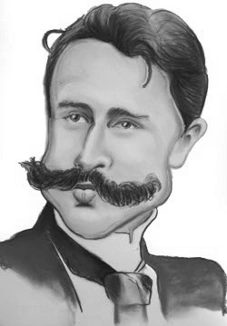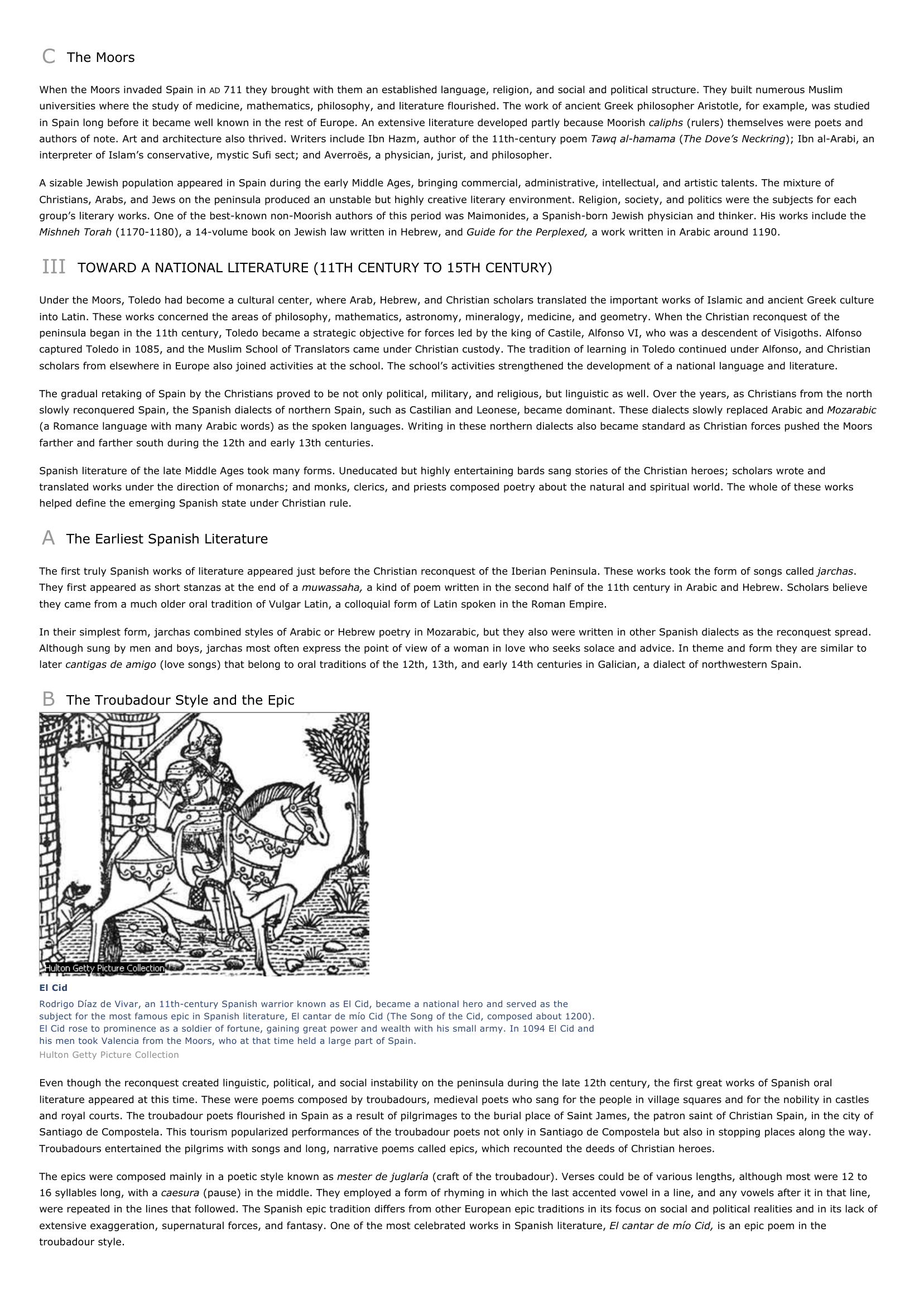En quoi peut-on dire que Jeanne symbolise le pessimisme de Maupassant?
Publié le 12/05/2013

Extrait du document


«
C The Moors
When the Moors invaded Spain in AD 711 they brought with them an established language, religion, and social and political structure.
They built numerous Muslim universities where the study of medicine, mathematics, philosophy, and literature flourished.
The work of ancient Greek philosopher Aristotle, for example, was studiedin Spain long before it became well known in the rest of Europe.
An extensive literature developed partly because Moorish caliphs (rulers) themselves were poets and authors of note.
Art and architecture also thrived.
Writers include Ibn Hazm, author of the 11th-century poem Tawq al-hamama (The Dove’s Neckring ); Ibn al-Arabi, an interpreter of Islam’s conservative, mystic Sufi sect; and Averroës, a physician, jurist, and philosopher.
A sizable Jewish population appeared in Spain during the early Middle Ages, bringing commercial, administrative, intellectual, and artistic talents.
The mixture ofChristians, Arabs, and Jews on the peninsula produced an unstable but highly creative literary environment.
Religion, society, and politics were the subjects for eachgroup’s literary works.
One of the best-known non-Moorish authors of this period was Maimonides, a Spanish-born Jewish physician and thinker.
His works include theMishneh Torah (1170-1180), a 14-volume book on Jewish law written in Hebrew, and Guide for the Perplexed, a work written in Arabic around 1190.
III TOWARD A NATIONAL LITERATURE (11TH CENTURY TO 15TH CENTURY)
Under the Moors, Toledo had become a cultural center, where Arab, Hebrew, and Christian scholars translated the important works of Islamic and ancient Greek cultureinto Latin.
These works concerned the areas of philosophy, mathematics, astronomy, mineralogy, medicine, and geometry.
When the Christian reconquest of thepeninsula began in the 11th century, Toledo became a strategic objective for forces led by the king of Castile, Alfonso VI, who was a descendent of Visigoths.
Alfonsocaptured Toledo in 1085, and the Muslim School of Translators came under Christian custody.
The tradition of learning in Toledo continued under Alfonso, and Christianscholars from elsewhere in Europe also joined activities at the school.
The school’s activities strengthened the development of a national language and literature.
The gradual retaking of Spain by the Christians proved to be not only political, military, and religious, but linguistic as well.
Over the years, as Christians from the northslowly reconquered Spain, the Spanish dialects of northern Spain, such as Castilian and Leonese, became dominant.
These dialects slowly replaced Arabic and Mozarabic (a Romance language with many Arabic words) as the spoken languages.
Writing in these northern dialects also became standard as Christian forces pushed the Moorsfarther and farther south during the 12th and early 13th centuries.
Spanish literature of the late Middle Ages took many forms.
Uneducated but highly entertaining bards sang stories of the Christian heroes; scholars wrote andtranslated works under the direction of monarchs; and monks, clerics, and priests composed poetry about the natural and spiritual world.
The whole of these workshelped define the emerging Spanish state under Christian rule.
A The Earliest Spanish Literature
The first truly Spanish works of literature appeared just before the Christian reconquest of the Iberian Peninsula.
These works took the form of songs called jarchas . They first appeared as short stanzas at the end of a muwassaha, a kind of poem written in the second half of the 11th century in Arabic and Hebrew.
Scholars believe they came from a much older oral tradition of Vulgar Latin, a colloquial form of Latin spoken in the Roman Empire.
In their simplest form, jarchas combined styles of Arabic or Hebrew poetry in Mozarabic, but they also were written in other Spanish dialects as the reconquest spread.Although sung by men and boys, jarchas most often express the point of view of a woman in love who seeks solace and advice.
In theme and form they are similar tolater cantigas de amigo (love songs) that belong to oral traditions of the 12th, 13th, and early 14th centuries in Galician, a dialect of northwestern Spain.
B The Troubadour Style and the Epic
El CidRodrigo Díaz de Vivar, an 11th-century Spanish warrior known as El Cid, became a national hero and served as thesubject for the most famous epic in Spanish literature, El cantar de mío Cid (The Song of the Cid, composed about 1200).El Cid rose to prominence as a soldier of fortune, gaining great power and wealth with his small army.
In 1094 El Cid andhis men took Valencia from the Moors, who at that time held a large part of Spain.Hulton Getty Picture Collection
Even though the reconquest created linguistic, political, and social instability on the peninsula during the late 12th century, the first great works of Spanish oralliterature appeared at this time.
These were poems composed by troubadours, medieval poets who sang for the people in village squares and for the nobility in castlesand royal courts.
The troubadour poets flourished in Spain as a result of pilgrimages to the burial place of Saint James, the patron saint of Christian Spain, in the city ofSantiago de Compostela.
This tourism popularized performances of the troubadour poets not only in Santiago de Compostela but also in stopping places along the way.Troubadours entertained the pilgrims with songs and long, narrative poems called epics, which recounted the deeds of Christian heroes.
The epics were composed mainly in a poetic style known as mester de juglaría (craft of the troubadour).
Verses could be of various lengths, although most were 12 to 16 syllables long, with a caesura (pause) in the middle.
They employed a form of rhyming in which the last accented vowel in a line, and any vowels after it in that line, were repeated in the lines that followed.
The Spanish epic tradition differs from other European epic traditions in its focus on social and political realities and in its lack ofextensive exaggeration, supernatural forces, and fantasy.
One of the most celebrated works in Spanish literature, El cantar de mío Cid, is an epic poem in the troubadour style..
»
↓↓↓ APERÇU DU DOCUMENT ↓↓↓
Liens utiles
- Disert Une vie Maupassant: Jeanne a-t-elle une vie si malheureuse ?
- LAMARE Jeanne de. Héroïne d'Une vie (1883), roman de Guy de Maupassant
- Invention : Lettre de jeanne (une vie de maupassant)
- Le pessimisme dans Une partie de Campagne (Maupassant et Renoir)
- POURQUOI JEANNE DÉSIRE-T-ELLE UN AUTRE ENFANT ? - Une Vie de Maupassant.




